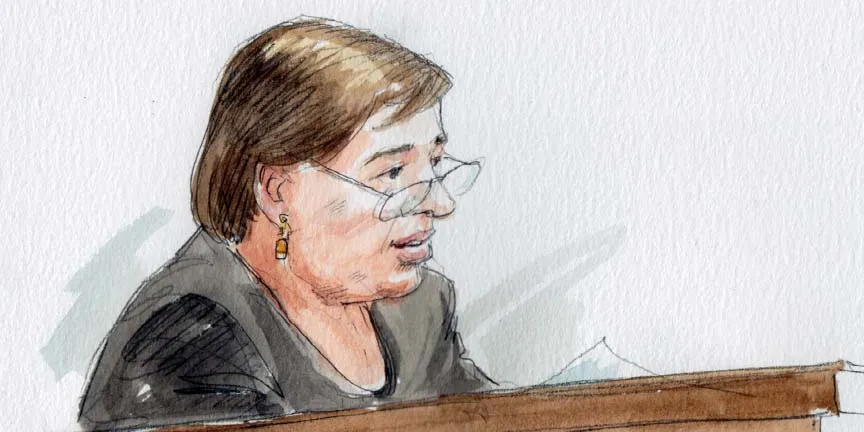Introducing lecture on World War I draft cases, Kagan lauds O’Connor’s work on civics education

on Oct 25, 2018 at 11:42 am

Justice Elena Kagan, speaking on Tuesday at the Supreme Court, briefly addressed “the very sad news” that former Justice Sandra Day O’Connor is “retiring from public life because she is in the early stages of dementia.”
“In very typical Justice O’Connor fashion,” Kagan continued, “she used this sad occasion to do good,” by releasing a letter in which “she talks about the importance of civic education for our society, for the way we govern ourselves, for the way we live in a democracy.”
“If you haven’t read her statement, please do so,” Kagan urged.
Kagan’s remarks were followed by a lecture by Professor Christopher Capozzola, the author of “Uncle Sam Wants You: World War I and the Making of the Modern American Citizen,” the latest in a series of events sponsored by the Supreme Court Historical Society to mark the centennial of World War I.
Capozzola’s topic – Arver v. United States, the lead among the Selective Draft Law Cases upholding the Selective Service Act of 1917 – “could have yielded an extraordinarily short lecture.” After all, the Supreme Court in January 1918 dispensed of challenges to the draft in a brief, unanimous opinion following an argument that, according to reports at the time, bored justices impatient with the issue.
Capozzola explained that for Chief Justice Edward White, consent was not a prerequisite for the duties of citizenship. As White wrote for the court, “power which has no sanction to it and which therefore can only be exercised provided the citizen consents to its exertion is in no substantial sense a power.”
And indeed, Congress did have expansive authority under the Constitution’s “raise and support Armies” clause, the court held: “The service which may be exacted of the citizen under the army power is not limited to the specific purposes for which Congress is expressly authorized” by other military clauses.
Two other arguments – that the law violated the 13th Amendment’s prohibition on involuntary servitude or the First Amendment’s establishment clause, because the draft exempted clergymen and divinity students – were rejected without substantive responses from White.
This result was unsurprising: “Every single court in the United States that heard a challenge to the draft rejected it,” Capozzola said.
And yet, Capozzola argued, “conscription and its enforcement marked a contingent and transformative moment for the Constitution, for the court, and for the American people.” “As drafted men and their families interacted with military administrators,” he continued, “they reworked the meanings of American citizenship and, in particular, the power of the government over our bodies and our souls.”
This reworking of citizenship happened in part through increased daily interactions between individuals and the federal government, which grew dramatically in size and power during World War I. Before the war, the largest federal budget had been $762 million; after the war, the smallest was $2.8 billion. During the war, the government also began intervening in disputes between labor and business, and it nationalized the railroad and coal industries. It literally changed the clocks with daylight-savings time.
The Selective Service Act of 1917 was another transformation in citizens’ relationship with the government, Capozzola argued.
First, universal male registration for the draft itself represented an innovation. Only eight percent of the Union’s forces during the Civil War came from conscription.
Second, in the early 20th century, many Americans lived without identification documents. Government agencies lacked the ability to identify all those under their authority. In order for the draft to work, men were asked to come from “off the grid,” locate themselves, and receive draft cards, the “first mass state-issued identity documents in U.S. history,” which they were legally required to carry and show upon request. Many did so freely, without complaint.
This spirit of voluntarism was encouraged. The day the draft was enacted, President Woodrow Wilson had declared it “in no sense a conscription of the unwilling,” but a “selection from a Nation which has volunteered.”
Of course, as Capozzola documented, this wasn’t exactly true. Although unbegrudging registration gave the draft an “aura of consent,” it obscured the truth of “a process that was fundamentally coercive.” And that coercion hit hard upon those who did not consent. For example, conscientious objectors faced considerable opposition, socially from fellow citizens and also from the federal government itself.
To reduce the number of conscientious objectors, Capozzola explained, the War Department established a Board of Inquiry, a three-person body that included the future Chief Justice Harlan Fiske Stone. Between June 1918 and the November armistice, the board interrogated conscientious objectors. Based on brief exchanges, often no more than a few minutes long, it legally determined objectors’ “sincerity.” Board-members actively tried to persuade men to serve. Among other arguments, they claimed that the war was in fact a “Christian Crusade” for which religious obligations demanded military service. The number of objectors dropped. For example, Capozzola detailed, of 177 objectors interviewed by the board at a camp near Atlanta in June 1918, only about three dozen were deemed “sincere.”
In 1936, Stone – who would later join the majority in West Virginia State Board of Education v. Barnette, upholding the right of students to refuse to salute the flag for religious reasons – was asked by a former conscientious objector if he’d had a change of heart about his work on the Board of Inquiry. Stone had not. “I believe that inasmuch as I must live in and be a part of organized society, the majority must rule,” Stone wrote in response, “and that consequently I must obey some laws of which I do not approve and even participate in a war which I may think ill-advised.”
Although the draft did not apply to women, the precedent established by Arver does “reappear in some surprising places,” with direct and indirect effects on women, Capozzola said. “The war’s coercions of all its citizens’ bodies,” Capozzola argued, “laid the groundwork for a new relationship between women and the state in the post-war era.”
First, in the 1929 case United States v. Schwimmer, the court ruled that a pacifist woman should be denied naturalization. The naturalization statute required an oath to protect the United States “against all enemies, foreign and domestic.” In a 6-3 opinion for the court, Justice Pierce Butler wrote, “That it is the duty of citizens by force of arms to defend our government against all enemies whenever necessity arises is a fundamental principle of the Constitution.” As his authority on this constitutional principle, he cited the Selective Draft Law Cases.
A second, indirect effect of the draft on women includes one of the court’s most “notorious” decisions, Capozzola said: Buck v. Bell, in which the court upheld the forced sterilization of “feeble minded” Carrie Buck.
During the war, women suspected of prostitution around military camps – who were predominantly young, working class, immigrants, or women of color, often guilty of nothing more than being unmarried women in public – were regularly detained, interned, or required to submit to medical examination. Women found to have venereal diseases could be forced into manual labor. Those considered “feeble minded” could be turned over to institutions, without their consent and with no formal hearing.
In the 1919 case McKinley v. U.S., Justice William Day wrote an opinion for the court upholding efforts to control prostitution around camps. Citing Arver, Day reasoned, “That Congress has the authority to raise and support armies and to make rules and regulations for the protection of the health and welfare of those composing them is too well settled to require more than the statement of the proposition.”
In addition, during the 1910s, states authorized sterilization of “feeble-minded” people in institutions, the eugenics practice upheld in 1927 in Buck. “Three generations of imbeciles are enough” – referring to Buck, her mother and her daughter – remains one of the most infamous lines from Justice Oliver Wendell Holmes’ opinion for the court.
Capozzola showed that the logic underpinning Holmes’ opinion derived from an analogy based on conscription. Holmes wrote:
We have seen more than once that the public welfare may call upon the best citizens for their lives. It would be strange if it could not call upon those who already sap the strength of the State for these lesser sacrifices, often not felt to be such by those concerned, in order to prevent our being swamped with incompetence.
As the centennial of the armistice approaches, Capozzola offered in closing, a fitting way to honor the occasion could be to go to a cemetery in Charlottesville, the final resting place of Carrie Buck.


